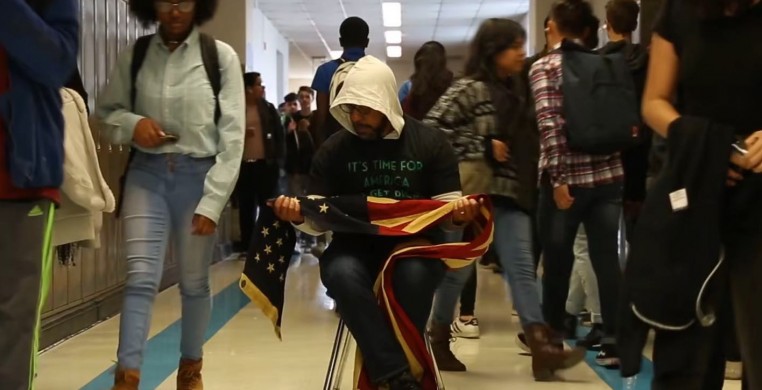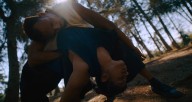The first time I saw Cecil McDonald, Jr.’s work it was during an informal visit to his studio at the Arts Incubator during his year as an artist in residence with Arts and Public Life. McDonald shared some of his photography in process at the time and I immediately connected to his subject matter, which at that time was movement and gesture. But it wasn’t your typical picturesque dancer shots; it was something a bit more layered. His shots were intimate, highlighting the subtle smirks on a face when a body moves, or the detail of a twirl in their skirt. He captured the nuances in movement that we often miss, cultural nuances especially. He captured them, and celebrated them, and held them at the center of our attention in a way that felt like no other aesthetic mattered. This style and celebration are a through line in McDonald’s work, from his House exhibition at the Department of Cultural Affairs, to his book, “In the Company of Black,” and most recently his “Cuts and Beats” exhibition at the Hyde Park Art Center. I chose to be in conversation with McDonald for the See Chicago Dance Screendance Club because he has always pushed dance to be something beyond performance, something deeply personal yet accessible, historical yet contemporary, political, communal and holy.
Although our Screendance Club conversation took place virtually several months ago, it still holds relevance as we continue to survive a global pandemic, find ways to protest our current circumstances, reflect on the ways that we uphold and interrupt our systems and consider the best tools to approach the teaching artist experience as we prepare to return to classrooms this fall. I moderated the conversation with McDonald as a fellow collaborator, friend and fan of him and his offerings. We began the hour-long conversation by simply viewing McDonald’s image that forms the base of his film, “Pieta for America.” Pietas are pictures or sculptures of the biblical Mary holding the dead body of Jesus on her lap. “Pieta for America,” or as McDonald describes it, “Pity for the American Condition,” is intended to be a contemporary approach to this historical reference.
The performance piece begins with a school bell and McDonald sitting alone in a chair in the middle of an empty hallway at Senn High School—one of the most culturally diverse schools in Chicago. McDonald is wearing a shirt that says “It’s time for America to get right” while holding an American flag similar to the fetal position of Jesus’s body held by Mary. When the bell rings, the hallway is flooded with energetic students during their passing period. During their urgent transition from one class to the next, they are forcefully urged to hurry to class while also being confronted by McDonald’s still and quiet posture taking up space in the center of the hallway. Some students choose to ignore it entirely while others inquire about his intentions, some students laugh, others do a double take, some are aware of the surveillance and simply apologize for being present in the camera’s view. For four minutes there is this beautiful contrast of students in organic transit weaving through and around a solemn McDonald cradling an American flag in a chair. The piece concludes in the circular pattern in which it began, with McDonald alone in the hallway and a ringing bell.
In the post-viewing talk, we danced around several through lines that presented themselves in this performance: the Black man as a caretaker, quiet protest, trusting your own experiences, and meeting young people where they are. The film stems from a collage of inspiration: from a reoccurring dream McDonald had of holding his grandfather in a nursing home; a Langston Hughes poem, “Let America be Great Again,” and years of introducing young people to the concept of proportion in the Vatican’s pieta sculpture. McDonald thought it would be interesting to bring these images together and explore the nuances of quiet protest.
“I didn’t want to make a protest because everyone was making a protest,” he said. “I wanted to show ways of protesting and celebrating protest and then time will take care of itself. The work matures and next thing you know, the work becomes as important as it was when you made it 10 years ago.”
Although “Pieta for America” was created in 2019 it still functions today as a politically timely work. Additionally, the dance film was also an opportunity for McDonald to find improvisational ways to reach the hearts of his students at Senn High School during his residency. McDonald shared that in his many years of working with young people in Chicago Public Schools, he has noticed three places where students truly come alive: in the gym, in the cafeteria and in the hallways. His intention was to resist a lot of the traditional performative aspects of the performance. He wanted to shock the students and surprise them. In his attempt to disrupt the status quo and simply meet students when their guards were down, he was able to tap into their curiosity. The connections were subtle, and he admits that most times students will keep their reactions close to their chests, but he reminds us that we encourage young people to ask questions and begin to participate by taking risk in our curriculum and going against the grain.
Naturally, McDonald interrupts the loud images we often see of Black men by simply being in this piece. He takes it a step further by taking on a caretaking role as he shows concern for the American condition. McDonald shared that in addition to being an artist he is also a caretaker and he has known many men in his lifetime that have been caretakers as well. It feels like something we inherently know as Black people: our granddaddies making us rice putting, our sons bringing smiles to our faces, our fathers washing our hair, our brothers taking us to school and our husbands carrying our bags. Black men have taken care of us for generations, yet it's an image we rarely see on a public stage. McDonald reminds us that “Pieta for America” is a nod to the caretaker in Black men.
Through surrender McDonald becomes a medium for the time and a life that is none other than his own. What I deeply appreciated about “Pieta for America” was how we were all able to find ways to access the conversation because the piece was not rooted in something narrow and superficial but rather in Cecil’s expansive passion of bringing bodies together. The high school students were able to see themselves and how they operate within the school system. The hall monitor was curious about her role and the position she plays in enforcing the rules. Cecil was able to reflect on his role as an interrupter and many of the viewers were able to witness the many structures in place that both aid and disrupt the American condition within both a school context and a larger framework. Because of this open way of working with time and experience he has been able to share the canon of his life through his art, rendering everything we see daily, with fresh eyes. By reclaiming work from the past and placing it in a contemporary landscape, McDonald is able to capture a spectrum of curiosity from the seasoned performer, to the novice student, to the passersby.
McDonald concluded the talk by saying, “It takes time to mature into knowing that your experiences will be enough for you to make work and you don’t have to rush around trying to find things that you need to force. Your art is in front of you.”
McDonald’s work encourages us to pay attention. To remember that life is more than mundane alarm clocks, to-do lists and being on someone else’s time. Perhaps there is something worthy in taking the long route home and stopping in our urgent tracks even if only to feel or sit in the inquisitive. His work whispers that it's perfectly OK to see a rare bird and take a moment to go and look it up.
In the spirit of McDonald’s artmaking and teaching process I’d like to think of this reflection following a similar vein. As we enter a new school year, in which teaching Critical Race Theory is in jeopardy, our mental and physical health is at risk and the world feels increasingly unstable, we can take a piece of McDonald’s wisdom and meet students where they are, share historical work in a familiar form and allow students to notice and reflect in their own subtle ways. Give them space and time to develop new understanding and be patient with the art/life making process. It takes time, patience and practice to connect the dots of our experiences and stand confidently in voices that are our own.
--
"Screendance Club: a radically casual watch-party, discussion of short dance films" takes place monthly. The next session, on Aug. 25, will be moderated by Jean Louise Osberger in conversation with Jason Jonas The Company. To register, click the event link below. To receive information about Screendance Club and other See Chicago Dance initiatives, sign-up for our newsletter.



